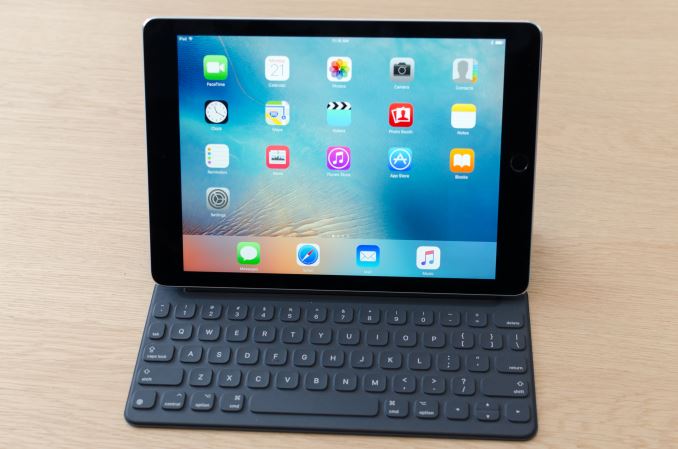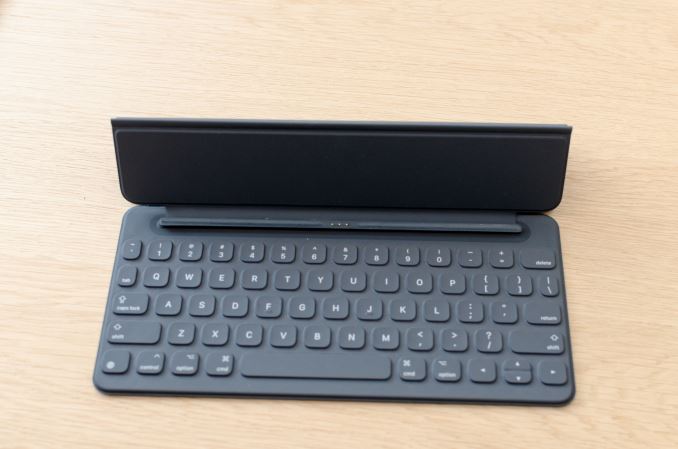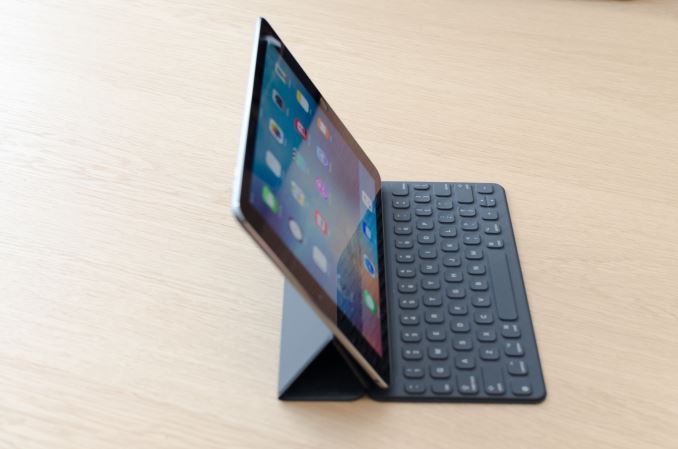Hands On With the Apple 9.7 Inch iPad Pro
by Joshua Ho on March 21, 2016 3:11 PM EST
Over the past few months I’ve been able to spend some quality time with the iPad Pro and I’ve found that while the iPad Pro isn’t quite a computer replacement in the sense that you should toss your laptop out, it is the first tablet that can actually justify itself relative to a phablet. With the 9.7” iPad Pro, Apple has been able to take the elements of the iPad Pro 12.9” that differentiated it from Android tablets and previous iterations of the iPad, and fit it in a smaller form factor.
The main points of differentiation that make this device more than an iPad Air 3 include the Apple Pencil, Smart Keyboard, and speakers. The Apple Pencil behaves identically relative to the larger device, but the smaller display size makes it feel more cramped. Other than this, the feel of the tip on the glass is identical, as is the pressure sensitivity, tilt sensitivity, and latency.
The Smart Keyboard for this version of the iPad Pro is significantly smaller than the version for the 13” iPad Pro. Right away it felt like it was a lot less comfortable to type on this iteration of the iPad Pro as a result as I couldn’t just rely on sheer muscle memory to place my fingers in the right place every time. However with some practice I was able to keep a typing pace that was pretty much identical, although it was relatively easy to make mistakes relative to a laptop keyboard because the keys are smaller so there’s less tolerance for errors in finger placement. With practice, like a smartphone keyboard, I’m sure it’ll be possible to type as quickly as you would on a laptop but I wasn’t able to reach that level of practice over the course of the two or so minutes I could spend with the keyboard.
Other than the size issue, everything else feels basically identical to the larger iteration of the Smart Keyboard. Those that love mechanical keyboards for their travel and tactile feedback will probably be disappointed by the feel, but I tend to bottom out keys no matter what keyboard I’m typing on so to me the relatively shallow travel of the keys was not a problem when it came to typing at a respectable rate.
Of course, the speakers are also shared with the iPad Pro, but in this case I wasn’t really able to test them properly as the hands on environment is rather chaotic and loud. I wouldn’t be surprised to know that the same speaker protection ICs are shared with the larger version of the iPad Pro for logistics reasons, but I wasn’t able to confirm that this is the case at the event. Similarly, the camera was not properly tested at the event as it wasn’t possible to do a proper comparison in the hands on environment.
The one other notable change that the 9.7” iPad Pro brings is True Tone display, which adjusts color temperature of the display based upon ambient light conditions. It turns out that this is something that you can toggle on and off on the fly, and the result that it produces seems to be designed to make the display more consistently neutral while other Apple mobile devices tend to end up with a colder white balance in most conditions. I didn’t see a toggle for color gamut, so it’s likely that the iPad Pro 9.7” is using either color management to enable a wider gamut on the fly or just displaying a wider color gamut all the time. To figure out which way Apple went here we’ll need to try a review unit, but given just how much emphasis Apple has placed on their displays I would be surprised if Apple wasn't employing color management.
Other than these points of differentiation, the iPad Pro 9.7” pretty much feels like any other iPad. However, there are a few notable changes to the design, including a camera hump to handle the 12MP camera and replacing the large plastic RF window on the LTE variants with an external aluminum antenna and insulating plastic to separate it from the rest of the chassis. It’s appreciably lighter than the iPad Pro 13”, but feels pretty much identical to the iPad Air 2 in terms of size and weight.
Overall, if you liked the 13” iPad Pro but didn’t want to deal with the extra size or weight, it looks like this will be exactly what you’re looking for.














67 Comments
View All Comments
Prod1702 - Saturday, March 26, 2016 - link
This is 100% not true. I love my SP4 as both a laptop and tablet. My wife mainly uses it with the keyboard, i mainly use the onscreen keyboard. I am buying a 9.7" iPad Pro to replace my Air 1, but the SP4 is hands down way better because it runs full windows programs. Nothing can touch that.Henry 3 Dogg - Wednesday, April 20, 2016 - link
"...but the SP4 is hands down way better because it runs full windows programs..."That is only better, if want to run Windows programs. From long, painful experience, I care about my data too much to trust it to any version of Windows.
So I only run Windows programs in a snapshotted virtual machine with all of the data on a [virtual] networked non Windows file system, and then roll the VM back after each use. Since the SP4 doesn't have enough RAM to make that practical, I wouldn't run Windows Programs on it anyway.
WillBthr - Saturday, March 26, 2016 - link
Surface 3 would be the comparison to this product and that is a huge stretch since Surface 3 runs Windows 10 and this Apple product runs their phone OS. $450 128GB / 4GB RAM USB3.I guess you (or your never heard of them link) speaks for everybody since you said "nobody" uses...
jollypike - Monday, March 21, 2016 - link
Interesting point but the Surface Pro runs Windows so whether it's a good or bad tablet is not relevant for some folks, myself included.I use, and can see value in Windows server (especially AD) and I've used Windows Desktop since version 1. I preferred GEM and Risc-OS but that was like Betamax v VHS again. At least Mac OS survived and flourished with a UNIX base.
secretmanofagent - Monday, March 21, 2016 - link
As an SP4 owner, it's incredibly relevant, because the damn thing can't sleep properly still. I get random wakeups, and different resources are using most of the CPU on wake and I have to reboot to clear it. That in itself makes it a horrible tablet.asfletch - Monday, March 21, 2016 - link
I agree - I have an HP Windows tab and most of the time it's actually quite good (browsing and switching between apps etc is actually snappier than my old Android tabs or my wife's iPad). However, at least once a week I pick it up to find it's gone from 80%+ battery to dead because of an update or other wakelock. If I could schedule all updates to happen only when on AC power I think it would make a big difference.DCide - Tuesday, March 22, 2016 - link
Isn't it amazing that after 30 years Microsoft still can't get it right? These are the types of problems that have always plagued them. Apple manages to rate somewhere around 8/10 in design and execution, while MS still languishes around 4 or 5/10 on a good day. Even when they come out with a great OS like Windows 8 they manage to mess it up with a schizophrenic UI and updates that continue to be pushed out for months on end after they're known to break a huge % of systems.While Apple has an advantage because they only have to support a small, controlled set of hardware targets, Microsoft has a mental problem. I suppose common sense isn't so common.
damianrobertjones - Tuesday, March 22, 2016 - link
Yet Apple can also get it wrong. Are you ignoring the iPad pro charging issues? Or the quick 'point' releases to iOS after a major update to fix things?damianrobertjones - Tuesday, March 22, 2016 - link
"Isn't it amazing that after 30 years Microsoft still can't get it right?"I'm sure that Intel has a part in all of this
name99 - Tuesday, March 22, 2016 - link
Is this Microsoft's fault or Intel's fault? My guess is that there's so much complexity in what's required to manage sleep on "the PC platform" (ie the full Intel setup of CPU and various buses and IO controllers) that no human being on earth can fully understand it and put together a completely successful control/state machine.Apple does a ridiculously good job of sleep/wake on iOS, but sleep/wake on OSX is merely OK --- it sorta works mostly, but at least once a month something goes wrong. And I'm unaware that Linux does a better job --- mostly you don't see the issue there because almost no-one is running Linux under the sort of aggressive sleep/wake patterns that people expect from OSX and Windows.
If no-one can get it right on Intel, and Apple/Android (and I think MS) can get it right on ARM, that seems to suggest the location of the problem, no?